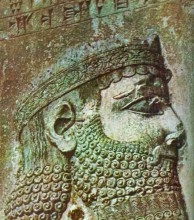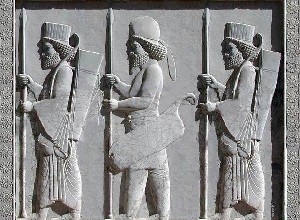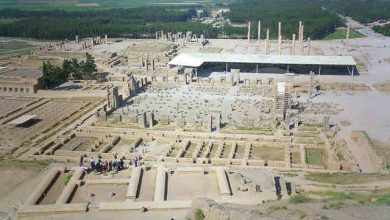Epitaphs of Iran's elders all over the world
to build the Suez Canal in Egypt Dariush, five inscriptions on a red granite stone (Sumac stone) It is written next to this important waterway which is a reminder of this great and amazing engineering and surveying program in ancient times. All five versions are copies of each other and do not differ much in content. The first inscription is located at the beginning of the waterway and on the outskirts of the current city of Suez. The second inscription is in the city of Shalov, which today is located in the middle of a field in this city. The third inscription was erected at the beginning of the bitter lake and in the place of the current city of Kebret/Match. The fourth inscription is located near the city of Sarabah/Sarabah Oum and the fifth inscription is located near Tel Maskhuta/Tal al-Maskhuta..
The same phonetic alliteration of two words
Tishtar and Tigre
In the Persian language, we are dealing with at least two separate words with two different meanings, both of which are written and read as "Tir".. One of these two is a palliative of the word "Tishtar" and is used as a name for the night star and the god associated with it, the first month of the summer season, the thirteenth day of every month in Iranian calendars, and also for the Tirgan festival on the thirteenth day of July.. The second of them is the stylization of the word "Tighreh" and is used as a name for the planet Mercury and the god associated with it, Khadang and what they throw with a bow, the Tigris River, and everything swift and hasty.. The two are often confused with each other and the meaning of each is attributed to the other.
Cyrus the Great
In traditional Romanian chronicles
The country of Romania was called "Dacia" in the distant times around the early centuries. Romanians, like many nations, have old and traditional chronicles in which people's beliefs and inferences about the creation of the world and mythological and historical events are revealed.. These stories, like all examples seen among other peoples of the world, are combined with legends and monographs.. یکی از مهمترین این آثار عبارت است از کتاب «رویدادنگاری» که «میهائیل موکسا/ میخائیل موکسالیه» (Mihail Moxalie) In the 16th/10th Iranian century, it was based on national narratives as well as reports from older Byzantine and Moldavian sources, such as the poem by Constantine Manasses. (Constantine Manasses) It was written and compiled by Iran from the 11th century AD/5th century. It is known that Moksalieh avoided adding exaggerated and imaginative narratives to his book as much as possible and used scholarly wisdom to select the narratives..
The letter of the new alphabet Ancient Persian cuneiform
Alphabetical cuneiform- Old Persian syllabary has 36 It is a sign or sign that the third sign from the second line of the Khark inscription has not been seen in any of the thirty-six known inscriptions and signs.. It seems that in a period decided for the syllable "neko" (nko) a part of which was not written but was read, a new sign should be established and the word "Sankosha" should be written in the Khark inscription. (sânkoŝâ) be used. If this comment (which can be clearly seen in the attached image) To be sure, now the thirty-seventh letter or symbol of ancient Persian cuneiform has been identified.
Khark inscription
A preliminary report on the reading of the new inscription in Khark Island
In the past few days, Mr. Hassan Zahoori- Kushai reporter of the Cultural Heritage Agency- Several reports of how The discovery of an inscription on Khark Island and also announced the suspension of road construction operations for further investigations in the area. This short report was written based on the photos that Mr. Zahoori kindly sent to this writer, and it will not replace the reports of researchers who will investigate it on the spot.. The Khark inscription was found in November of this year in the process of building a road on Khark Island. The inscription was written on the native coral stone of the island with a width and length of approximately one meter, and although it is now separated from its original place, it was originally an immovable effect on the coral reefs of the island..
سنگنبشته خشیارشا شاه
در شهر وان
شهر وان در پنج کیلومتری شرق دریاچهای به همین نام در آناتولی شرقی قرار دارد. این شهر و دشتهای پیرامون آن، کهنترین استقرارگاه کشور باستانی «اوروآتری» Uruatri ( In ancient Persian: "Arminah/Armenia, in Babylonian and Assyrian: Urartu) have been. This city and lake are known as "Biaini" and "Nairi" in the Urartian language, and the castle-like city of Toushapa/Tospa, the capital of the Urartians in the first centuries of the 1st millennium BC, was also in this area.. Remains of Urartian monuments and works of Toshpa, in the castle and hills in the west of the modern city of Van (which are called "Old Bath".) And at a distance of two kilometers from the shore of the lake, it still remains.
Kafterli rocks
The second new inscription in geometric script in Iran
The second rock inscription in geometric script along with a large number of pictures of animals and hunters has been identified in Akhtar Abad Shahriar plain..
Some time ago, Mr. Rahimi (Manager of Shahriar cultural heritage base) He informed me about the discovery of painters in Shahryar and then kindly took me to visit them. After visiting and examining these rock stumps full of drawings, many similar examples of which have been seen in different areas, I realized the existence of several special signs of the geometric line that was also seen in the Konchermi stone inscription, and in this way, the second rock inscription of this line. It was known in Iran. Mount Kaftarli in Shahryar is of special importance due to the removal of an ancient inscription that has only one similar example in the whole country, which needs to be investigated with comprehensive studies..
The religion of Mazdak according to the narrative of Dinkord
The only surviving text of the Mazdakians' conversation with the Zoroastrian clergy
In the first years of the beginning of the Sasanian kingdom and with the support of Ardeshir Babakan, a new religion named "Bahdini" or "Mazdisna" (Mazda worship) It was created by Mobad Kartier that after approx 1700 year and in the last century it was renamed to "Zoroastrian religion" and has nothing to do with Zoroastrian.
The influence and interference of Zoroastrian priests of the Sassanid era in the religious norms of the people, the distortion and destruction of the culture and history of Iran, the killing and destruction of the followers of other religions and their places of worship. (which Cartier has explicitly mentioned in his famous inscription in Rostam), weakens the national identity, historical background and solidarity of Iranians and destroys the cultural and social foundations of Iranians in such a way that it paves the way for Azmand invaders to conquer Iran..
Throughout the period of the religious domination of the Sassanid era, there were various movements to free the Iranian society from the clutches of religious monopolists and oppressors of social and individual freedoms, all of which were suppressed and destroyed by two powerful tools that have always been valid in Iran and the world.: First, using military power and bayonet force; Second, taking advantage of religious power and accusation of apostasy and disbelief.
The events of Nebonid and Cyrus the Great
The oldest inscription from the time of Achaemenid Cyrus
Do not write an event log- Kourosh (The first Persian translation of its full text is published here), the last example of the ancient tradition of writing chronicles based on chronology in Mesopotamia (Mesopotamia) Is. Do not write this inscription to record the events of the first year of the kingdom (556/ 555 before Christ) Until the first year of Cyrus the Great's reign over Babylon (539/ 538 before Christ) and it was written during the reign of Cyrus and before his famous charter. Although this document is very short and damaged, it is very important in several ways:
The oldest written document from the time of Cyrus the Great Achaemenid; The oldest source recounts Cyrus' conquest of other lands, including the capture of Babylon; The oldest narrator of the mutual attacks of Astyages and Cyrus, introducing Astyages as the initiator of the battle and then the fall of Astyages, the last king of the Medes and the end of the Median empire; The events of the years of the reign of the last king of Babylon and the permanent end of its independence.
Don't write charters
Inscription of the last king of Babylon
do not see (Nebonidus) He is the last king in the tradition of the Babylonian kingdom, which ended his kingdom and the independence of his country after the defeat of Achaemenid Cyrus II.. He for seventeen years of the year 556 until the year 539 BC was the king of Babylon. . . In addition to its other historical significance, the Nebonid Charter is the oldest source that mentions Cyrus and his battle with Astyages, the last king of the Medes.. It is interesting that this reference to Cyrus is narrated in the text of the inscription from the language of Marduk, the great Babylonian god.
Kancharmi inscription
A preliminary report on ancient and new rock inscriptions in Iran
In the spring of last year, I found out about the existence of carvings near the village of "Kanchermi" in the north of Bijar city, through the oral reports of the native people of the eastern regions of Kurdistan.. Those words were not enlightening enough to determine whether we would encounter a petroglyph or an inscription in that area.. I decided to get some information about it before traveling to the region. I discussed the issue with some friends and then with Dr. Saeed Arian, a prominent scholar of Pahlavi language.. But none of them had heard or read the name or report of such a writer. In July of the year 1384 With the guidance of a young man from the same village named Rahim Konchermi, I managed to visit the rock and prepare preliminary reports and photos..
Charter of Achaemenid Cyrus
Taken from the fifth edition of the book "Manshor Koresh Achaemenashi" by the same author (1384)
The Achaemenid Charter of Cyrus is the oldest known human rights statement in the world and a proud document of Iranians for peaceful coexistence and honoring the beliefs and thoughts of all subject peoples at the time of the foundation of the world's first empire.. The ancient world has always suffered from endless wars and attacks, and countries seeking peace have had to confront and conquer them in order to free their people from the constant raids of restless neighbors.. But the important thing is, how did the victors of the battlefield treat the broken army and subordinate people? Human histories have recounted the good behavior of Cyrus the Great, the king of the most powerful country in the world at that time, and the aggressive actions of other Gati rulers..
Rabatak stone inscription
An open window on Iranian culture and Aryan language
The discovery of the Rabatak stone inscription answered several long-standing questions in the field of Kushan studies. According to this inscription, it is known that the Kushans knew their language as "Aryan language" and it is the ancestor of Persian or Dari language, which seems to be "Dari" is a modified version of the word "Ariyao".. The Aryan language and its evolved variant called Dari/Persian is the common language of the people of the Iranian lands, and "Persia" is not the only region of Fars in the south of Iran; Rather, it refers to all Iranian lands. In its first and later forms, this language was widespread and understood in a wide area from western Iran at that time, Anatolia and the banks of the Euphrates to India, Punjab and Central Asia..
The inscription of Darius the Great in Biston
full text
Taken from the third edition of the book "Biston, the inscription of Darius the Great" by the same author (1384)
From “Dariush” (Dariush), the great king, the king of kings, the king in "Parse" (Pars), the king of the lands, the son of "Vishtasape" (Vishtasap), the nucleus of “Arshamah” (Arsham)Achaemenid. Dariush Shah says: My father Vishtasep, Vishtasep Arsham's father, Arsham's father "Ariyaramne" (Aryaramneh), father of Aryaramaneh "Cheshpesh" (What's up), the father of Chishpiseh is "Hakhamanesh".
about
The inscription of Darius the Great in Biston
The way that the cities of Hamedan, Kangavar, Kermashan today (Kermanshah), Sarpol-Zehab, Qasr-Shirin and Khosravi will go to the land of Andor (Mesopotamia) links; The same ancient road is thousands of years old, which connects the eastern and middle lands of Iran to the western lands and to Babylon, Nineveh and other cities of the Middle East.. This way in 30 Kilometers away from Kermanshah, it covers Khorram Bistun plain and the slopes of "Peru" mountain. This Khormi owes more than anything to the raging Gamasiyab river and the ancient always-boiling spring of Biston.. Along this road and especially in Biston, many ancient monuments can be seen, which were a sign of the special approach of the ancients to this order..
Tablets of Persepolis
Basic documents of social and administrative systems in Achaemenid Iran
Several types of inscriptions from the Achaemenid period have been seen and obtained in Takht Jamshid. One, the stone inscriptions of the Achaemenid kings written in "Old Persian" language and cuneiform on the stone facade of the palaces and buildings of Persepolis and usually translated into cuneiform and "Elamite" and "New Babylonian" languages. (Akkadian)They are together. Second, the gold and silver tablets of Darius the Great, which were found in stone chests at the base of the walls of the Apadana Hall, and one of its gold tablets was missing a few years ago, and after many contradictory comments about its fate, it was finally said that one of The officials of the Museum of Ancient Iran stole it and "watered" it. Third, the inscriptions that have been seen on objects such as weight stones, seals, door handles, glazed bricks and various vessels..
The story of the birth of Zarathustra
Every nation and nation, apart from scientific or historical documentary sources, also has stories and beliefs about the birth, life and death of its prophets and elders.. Although such stories can be less useful in scientific and historical researches, their greater importance lies in examining the feelings, thinking and ideals of the people who created them.
The fifth inscription of Darius Shah
in Susa
From Darius the Great, many inscriptions have been found in the city of Susa, which were written on marble stones, pastons, clay tablets or on bricks.. Most of these inscriptions, like other Achaemenid inscriptions, are in ancient Persian, Elamite, and Babylonian languages.. The text below is the Persian report of one of the most important inscriptions of Darius the Great, namely his fifth inscription in Susa (DSeF1E6CA>) in which Dariush's thoughts on peace-seeking and territorial solidarity, development and order of cities, protection of the disabled, permanence of the homeland and many other important points are mentioned.. This short inscription, together with the original ancient Persian cuneiform script, the inscription and some explanations by this author, is in print and its easy-to-read translation is published here..
Old Avesta
Along with hypotheses about the astronomy of the ancient parts of the Avesta
The book "Avesta", the oldest collection of Iranian writings, has been repeatedly damaged by time.. As far as historical information is available, once during the military and cultural attack of Alexander the Great on the land of Iran and the burning and destruction of the Avesta, the original text of which was written on twelve thousand cow skins; Even if the figure of 12,000 seems exaggerated, the Avesta book was so big that Pahlavi and Islamic writers and historians without any doubt put this big figure in their works.. and other times of the destruction of large parts of the Avesta—as has been said- It happened during the attack of Arabs and Mongols on the land of Iran. But if we judge fairly, we should not forget the sad fact that the noteworthy parts of the Avesta have been lost and forgotten due to the carelessness of us Iranians.. From the works of Abu Rihan Biruni and other writers of his time, it is correctly understood that parts of the Avesta, which are not available today, were available in their time and they cited them in their writings.. On the other hand, it should not be ignored that the Avesta was a collection of various writings, and parts of these writings that had a scientific and scholarly approach - as a result of public neglect- They have disappeared and been forgotten earlier than the religious parts that are more important to everyone.
The damage done to the Avesta book does not include only the missing parts; Moreover, the additions and changes of the Sassanid era are also considered among these damages. These changes were made in order to adapt the text of the Avesta to the fake Zoroastrian religious beliefs of the Sassanians - which was significantly different from the Zoroastrian ritual.







I enjoyed
Greetings, it would be nice if a picture of the desired inscription was printed under each article..
Thank you for your suggestion
Thanks
good luck